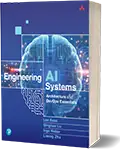Engineering AI Systems
Artificial Intelligence
Book Details
Book Title
Engineering AI Systems
Author
Len Bass; Qinghua Lu; Ingo Weber; Liming Zhu
Publisher
Addison-Wesley
Publication Date
2025
ISBN
9780138261450
Number of Pages
613
Language
English
Format
File Size
7.1MB
Subject
Artificial Intelligence
Table of Contents
- Cover Page
- About This eBook
- Title Page
- Copyright Page
- Contents
- Preface
- Acknowledgments
- About the Authors
- 1. Introduction
- 1.1 What We Talk about When We Talk about Things: Terminology
- 1.2 Achieving System Qualities
- 1.3 Life-Cycle Processes
- 1.4 Software Architecture
- 1.5 AI Model Quality
- 1.6 Dealing with Uncertainty
- 1.7 Summary
- 1.8 Discussion Questions
- 1.9 For Further Reading
- 2. Software Engineering Background
- 2.1 Distributed Computing
- 2.2 DevOps Background
- 2.3 MLOps Background
- 2.4 Summary
- 2.5 Discussion Questions
- 2.6 For Further Reading
- 3. AI Background
- 3.1 Terminology
- 3.2 Selecting a Model
- 3.3 Preparing the Model for Training
- 3.4 Summary
- 3.5 Discussion Questions
- 3.6 For Further Reading
- 4. Foundation Models
- 4.1 Foundation Models
- 4.2 Transformer Architecture
- 4.3 Alternatives in FM Architectures
- 4.4 Customizing FMs
- 4.5 Designing a System Using FMs
- 4.6 Maturity of FMs and Organizations
- 4.7 Challenges of FMs
- 4.8 Summary
- 4.9 Discussion Questions
- 4.10 For Further Reading
- 5. AI Model Life Cycle
- 5.1 Developing the Model
- 5.2 Building the Model
- 5.3 Testing the Model
- 5.4 Release
- 5.5 Summary
- 5.6 Discussion Questions
- 5.7 For Further Reading
- 6. System Life Cycle
- 6.1 Design
- 6.2 Developing Non-AI Modules
- 6.3 Build
- 6.4 Test
- 6.5 Release and Deploy
- 6.6 Operate, Monitor, and Analyze
- 6.7 Summary
- 6.8 Discussion Questions
- 6.9 For Further Reading
- 7. Reliability
- 7.1 Fundamental Concepts
- 7.2 Preventing Faults
- 7.3 Detecting Faults
- 7.4 Recovering from Faults
- 7.5 Summary
- 7.6 Discussion Questions
- 7.7 For Further Reading
- 8. Performance
- 8.1 Efficiency
- 8.2 Accuracy
- 8.3 Summary
- 8.4 Discussion Questions
- 8.5 For Further Reading
- 9. Security
- 9.1 Fundamental Concepts
- 9.2 Approaches to Mitigating Security Concerns
- 9.3 Summary
- 9.4 Discussion Questions
- 9.5 For Further Reading
- 10. Privacy and Fairness
- 10.1 Privacy in AI Systems
- 10.2 Fairness in AI Systems
- 10.3 Achieving Privacy
- 10.4 Achieving Fairness
- 10.5 Summary
- 10.6 Discussion Questions
- 10.7 For Further Reading
- 11. Observability
- 11.1 Fundamental Concepts
- 11.2 Evolving from Monitorability to Observability
- 11.3 Approaches for Enhancing Observability
- 11.4 Summary
- 11.5 Discussion Questions
- 11.6 For Further Reading
- 12. The Fraunhofer Case Study
- 12.1 The Problem Context
- 12.2 Case Study Description and Setup
- 12.3 Summary
- 12.4 Takeaways
- 12.5 Discussion Questions
- 12.6 For Further Reading
- 13. The ARM Hub Case Study
- 13.1 Introduction
- 13.2 Our Approach
- 13.3 LLMs in SME Manufacturing
- 13.4 A RAG-Based Chatbot for SME Manufacturing
- 13.5 Architecture of the ARM Hub Chatbot
- 13.6 MLOps in ARM Hub
- 13.7 Ongoing Work
- 13.8 Summary
- 13.9 Takeaways
- 13.10 Discussion Questions
- 13.11 For Further Reading
- 14. The Banking Case Study
- 14.1 Customer Churn Prediction
- 14.2 Key Challenges in the Banking Sector
- 14.3 Summary
- 14.4 Takeaways
- 14.5 Discussion Questions
- 14.6 For Further Reading
- 15. The Future of AI Engineering
- 15.1 The Shift to DevOps 2.0
- 15.2 AI’s Implications for the Future
- 15.3 AIWare or AI-as-Software
- 15.4 Trust in AI and the Role of Human Engineers
- 15.5 Summary
- 15.6 Discussion Questions
- 15.7 For Further Reading
- References
- Index
